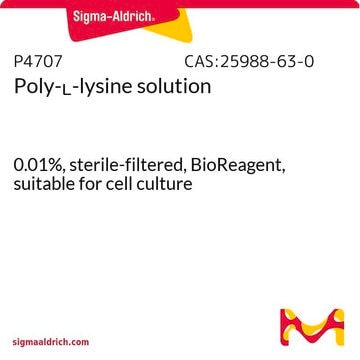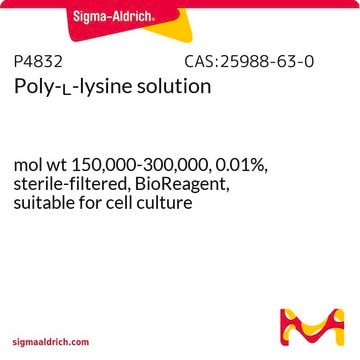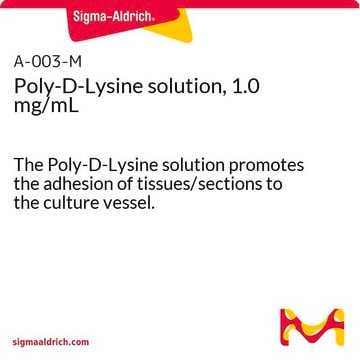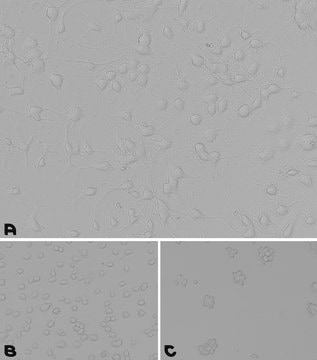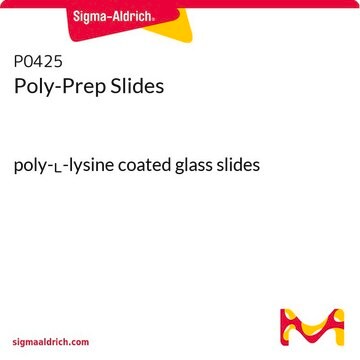A-005-M
Poly-ʟ-Lysine Hydrobromide
synthetic, liquid, 0.1 mg/mL, suitable for cell culture
Synonym(s):
Lysine
Sign Into View Organizational & Contract Pricing
All Photos(1)
About This Item
UNSPSC Code:
12352209
eCl@ss:
32160801
NACRES:
NA.75
Recommended Products
Product Name
Poly-L-Lysine Solution, 0.01%
biological source
synthetic
Quality Level
needle size
2.0 mm
sterility
sterile
form
liquid
mol wt
Mw 84000 Da
manufacturer/tradename
NovaSeptum®
concentration
0.01 % (w/v)
0.1 mg/mL
technique(s)
cell attachment: suitable
cell culture | mammalian: suitable
shipped in
dry ice
storage temp.
−20°C
General description
Poly-L-Lysine is a synthetic amino acid chain that is positively charged having one hydrobromide per unit of Lysine. Poly-L-Lysine is widely used as a coating to enhance cell attachment and adhesion to both plasticware and glass surfaces. Certain cell types secrete proteases, which can digest Poly-L-Lysine.
The molecular weight of Poly-L-Lysine for cell culture can vary significantly, with lower molecular weight (30,000 Da) being less viscous and higher molecular weight (greater than 300,000 Da) having more binding sites per molecule. This product uses a Poly-L-Lysine of 84000 Da, yielding a solution viscosity for easy handling while providing sufficient binding sites for cell attachment.
The molecular weight of Poly-L-Lysine for cell culture can vary significantly, with lower molecular weight (30,000 Da) being less viscous and higher molecular weight (greater than 300,000 Da) having more binding sites per molecule. This product uses a Poly-L-Lysine of 84000 Da, yielding a solution viscosity for easy handling while providing sufficient binding sites for cell attachment.
Application
Poly-L-Lysine Solution has been used to coat culture dishes to culture U2-OS cells and primary cortical neurons.
Biochem/physiol Actions
Poly-L-lysine serves as a coating substance to ensure better attachment of cells to culture surfaces. Research shows that plates coated with poly-L-lysine (PLL) demonstrated an accelerated cell growth rate. Culturing mesenchymal stem cells (MSCs) on PLL-coated substrates has been found to safeguard the stemness properties of these cells and inhibit senescence. PLL-coated plates have demonstrated enhanced MSC growth and up-regulated the expression of genes associated with cell adhesion, differentiation, proliferation, and signaling. Moreover, porous PLL-coated surfaces have shown improvements in cell proliferation and the osteogenic differentiation of MSCs.
Quality
Solution is clear with no particulates present. Solution is sterile and suitable for cell culture applications.
Preparation Note
Optimal coating concentrations must be determined by the end user. Typical coating concentrations range from 10ug/ml to 100ug/ml based on cell type and application.
1. Thaw Poly-L-Lysine solution at room temperature.
2. Dilute Poly-L-Lysine solution to the desired concentration in sterile water.
3. Fully coat the cell culture surface with diluted Poly-L-Lysine solution. Use 5 mL volume for 6-cm plates and 10 mL volume for 10-cm plates and T75 flasks.
4. Allow the cell culture vessel to sit at room temperature overnight.
5. Aspirate the Poly-L-Lysine solution the following day and rinse the vessel with sterile water followed by coating with desired ECM protein.
1. Thaw Poly-L-Lysine solution at room temperature.
2. Dilute Poly-L-Lysine solution to the desired concentration in sterile water.
3. Fully coat the cell culture surface with diluted Poly-L-Lysine solution. Use 5 mL volume for 6-cm plates and 10 mL volume for 10-cm plates and T75 flasks.
4. Allow the cell culture vessel to sit at room temperature overnight.
5. Aspirate the Poly-L-Lysine solution the following day and rinse the vessel with sterile water followed by coating with desired ECM protein.
Legal Information
NOVASEPTUM is a registered trademark of Merck KGaA, Darmstadt, Germany
Storage Class Code
12 - Non Combustible Liquids
WGK
WGK 1
Flash Point(F)
Not applicable
Flash Point(C)
Not applicable
Certificates of Analysis (COA)
Search for Certificates of Analysis (COA) by entering the products Lot/Batch Number. Lot and Batch Numbers can be found on a product’s label following the words ‘Lot’ or ‘Batch’.
Already Own This Product?
Find documentation for the products that you have recently purchased in the Document Library.
Customers Also Viewed
Srsf1 and Elavl1 act antagonistically on neuronal fate choice in the developing neocortex by controlling TrkC receptor isoform expression
A Ioana Weber, et al.
Nucleic Acids Research, 10218-10237 (2023)
Poly-L-lysine Prevents Senescence and Augments Growth in Culturing Mesenchymal Stem Cells Ex Viv
Heo JS, et al.
BioMed Research International (2016)
Polylysine for skin regeneration: A review of recent advances and future perspectives
Zarrintaj P, et al.
Bioengineering & translational medicine, 5;7(1) (2022)
Direct addition of poly-lysine or poly-ethylenimine to the medium: A simple alternative to plate pre-coating
Alexander Faussner, et al.
PLoS ONE, 17(7), e0260173-e0260173 (2022)
Ana Popović et al.
Journal of cell science, 136(5) (2023-03-03)
Myosin-X (MYO10), a molecular motor localizing to filopodia, is thought to transport various cargo to filopodia tips, modulating filopodia function. However, only a few MYO10 cargoes have been described. Here, using GFP-Trap and BioID approaches combined with mass spectrometry, we
Our team of scientists has experience in all areas of research including Life Science, Material Science, Chemical Synthesis, Chromatography, Analytical and many others.
Contact Technical Service